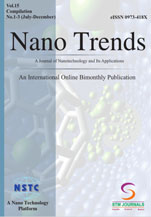
K.Surendra Reddy

Kuruva Ramanjaneyulu

Daggulu Lakshmi Charitha

M.Rani

K.Mohammad Muddasir

Ch.Thirupathamma,

N.Naveen
- Associate Professor Indira Institute of Technology & Sciences Andhra Pradesh India
- Students Indira Institute of Technology & Sciences Andhra Pradesh India
- Students Indira Institute of Technology & Sciences Andhra Pradesh India
- Students Indira Institute of Technology & Sciences Andhra Pradesh India
- Students Indira Institute of Technology & Sciences Andhra Pradesh India
- Students Indira Institute of Technology & Sciences Andhra Pradesh India
- Students Indira Institute of Technology & Sciences Andhra Pradesh India
Abstract
One of the most common and deadly types of cancer in the world is colorectal cancer, and enhancing patient outcomes requires early identification. This chapter explores the potential of nanotechnology-enhanced biosensors and artificial intelligence/machine learning (AI/ML) algorithms to revolutionize colorectal cancer screening and diagnosis. Nanotechnology offers unique opportunities to develop highly sensitive and specific biosensors capable of detecting cancer biomarkers at early stages. By incorporating nanomaterials with exceptional optical, electrical, and catalytic properties, these biosensors can achieve unprecedented levels of sensitivity and selectivity. Additionally, the integration of AI/ML algorithms with biosensor data can further enhance diagnostic accuracy, enabling early detection and personalized treatment strategies. This chapter delves into the latest advancements in nanomaterial-based biosensors, AI/ML algorithms for cancer diagnosis, and their synergistic application in colorectal cancer screening. It also discusses the challenges, future perspectives, and potential impact on improving patient care and reducing the burden of colorectal cancer.
Keywords: Colorectal cancer, biosensors, nanotechnology, nanomaterials, cancer biomarkers, artificial intelligence, machine learning, early detection, personalized medicine.
[This article belongs to Nano Trends-A Journal of Nano Technology & Its Applications(nts)]
References
1.Center MM, Jemal A, Smith RA, Ward E. Worldwide variations in colorectal cancer. CA Cancer J Clin. 2009;59(6):366-78.
2.Lee J, Maji S, Lee H. Fabrication and integration of a low‐cost 3D printing‐based glucose biosensor for bioprinted liver‐on‐a‐chip. Biotechnol J. 2023;18(12):2300154.
3.Sudharshan VB, Eswaran U, Eswaran V, Eswaran V, Murali K. Human like biosensor disease simulator, disease analyzer and drug delivery system. In: 2013 IEEE Conference on Information and Communication Technologies (ICT 2013). 2013. p. 1033-8.
4.Eswaran U. Fortifying cybersecurity in an interconnected telemedicine ecosystem. In: Improving Security, Privacy, and Connectivity Among Telemedicine Platforms. 2024. p. 30-60.
5.Ganji MR, et.al., Expert system design for disease detection using pattern recognition techniques. In: Proceedings of the 2008 International Conference on Artificial Intelligence and 2008 International Conference on Machine Learning; Models, Technologies and Applications. 2008. p. 902-6.
6.Madhavilatha M, et.al., A proposal for design of hybrid multi-functional implantable biochip using bio-intelligent expert system. In: Proceedings of the 2006 International Conference on Artificial Intelligence. 2006;2:426-32.
7.Thakur MS, et.al., Microprocessor based biosensors for determination of toxins and pathogens in restricted areas of human intervention. In: Proceedings of the International Conference on Artificial Intelligence, IC-AI’04. 2004;1:525-31.
8.Khang A. Augmented Reality (AR) and Virtual Reality (VR) Technologies in Surgical Operating Systems. InAI and IoT Technology and Applications for Smart Healthcare Systems 2024 May 15 (pp. 113-129). Auerbach Publications..
9.Min J, Baeumner AJ. Characterization and optimization of interdigitated ultramicroelectrode arrays as electrochemical biosensor transducers. Electroanalysis: An International Journal Devoted to Fundamental and Practical Aspects of Electroanalysis. 2004 May;16(9):724-9.
10.Vishal.et.al, Applying machine learning for medical image processing. In: AI and IoT-Based Technologies for Precision Medicine. 2023. p. 137-54.
11.Murali K. Revolutionizing Healthcare: The Application of Image Processing Techniques. InMedical Robotics and AI-Assisted Diagnostics for a High-Tech Healthcare Industry 2024 (pp. 309-324). IGI Global.
12.Eswaran U, Khang A. Artificial Intelligence (AI)-Aided Computer Vision (CV) in Healthcare System. InComputer Vision and AI-Integrated IoT Technologies in the Medical Ecosystem 2024 Mar 29 (pp. 125-137). CRC Press.
13.Eswaran U, Eswaran V, Murali K, Eswaran V. Healthcare Smart Sensors: Applications, Trends, and Future Outlook. InDriving Smart Medical Diagnosis Through AI-Powered Technologies and Applications 2024 (pp. 24-48). IGI Global.
14.Markus AF, Kors JA, Rijnbeek PR. The role of explainability in creating trustworthy artificial intelligence for health care: a comprehensive survey of the terminology, design choices, and evaluation strategies. Journal of biomedical informatics. 2021 Jan 1;113:103655..
15.Amann J, Blasimme A, Vayena E, Frey D, Madai VI, Precise4Q Consortium. Explainability for artificial intelligence in healthcare: a multidisciplinary perspective. BMC medical informatics and decision making. 2020 Dec;20:1-9.
16.Acosta JN, Falcone GJ, Rajpurkar P, Topol EJ. Multimodal biomedical AI. Nature Medicine. 2022 Sep;28(9):1773-84.
17.Kim M, Kang D, Kim MS, Choe JC, Lee SH, Ahn JH, Oh JH, Choi JH, Lee HC, Cha KS, Jang K. Acute myocardial infarction prognosis prediction with reliable and interpretable artificial intelligence system. Journal of the American Medical Informatics Association. 2024 May 28:ocae114..
18.Chugh V, Basu A, Kaushik A, Bhansali S, Basu AK. Employing nano-enabled artificial intelligence (AI)-based smart technologies for prediction, screening, and detection of cancer. Nanoscale. 2024..
19.Brandalero M, Ali M, Le Jeune L, Hernandez HG, Veleski M, Da Silva B, Lemeire J, Van Beeck K, Touhafi A, Goedemé T, Mentens N. Aitia: Embedded ai techniques for embedded industrial applications. In2020 International Conference on Omni-layer Intelligent Systems (COINS) 2020 Aug 31 (pp. 1-7). IEEE..
20.Shrivastava S, Patel D, Gifford WM, Siegel S, Kalagnanam J. Thunderml: A toolkit for enabling ai/ml models on cloud for industry 4.0. InWeb Services–ICWS 2019: 26th International Conference, Held as Part of the Services Conference Federation, SCF 2019, San Diego, CA, USA, June 25–30, 2019, Proceedings 26 2019 (pp. 163-180). Springer International Publishing

Nano Trends-A Journal of Nano Technology & Its Applications
| Volume | 26 |
| Issue | 01 |
| Received | May 31, 2024 |
| Accepted | June 8, 2024 |
| Published | June 13, 2024 |

